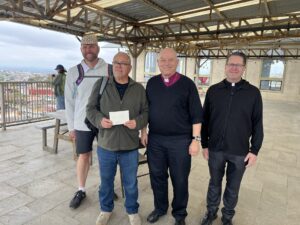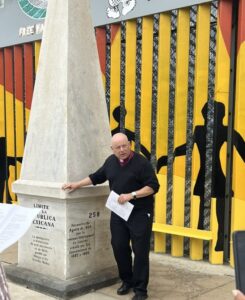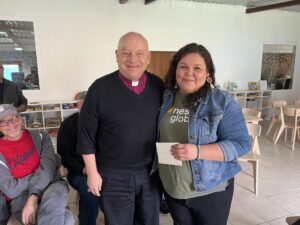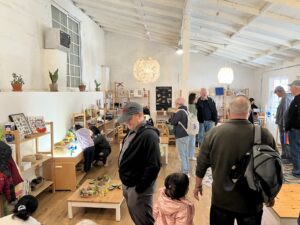What is the real situation at the Southern Border? What can we, as people of faith and Episcopalians, do?
These two questions inspired the “Mission to the Border” organized by the Sanctuary Task Force of the Diocese on Tuesday, May 2. The one-day visit was attended by seventeen people including Bishop John Harvey Taylor; the Rev. Norma Guerra, associate for formation and transition ministry; and Robert Vivar, missioner for migrant ministries in the Episcopal Diocese of San Diego.
The “Mission to the Border” began with a reverse-migration, walking from the U.S.-side to Tijuana. The group boarded a bus from Eunime, a nonprofit serving children and youth with HIV, and made its way to one of Tijuana’s largest migrant shelters, a former warehouse turned church, established by Iglesia Embajadores de Jesus. During the height of Covid, the shelter was home to over 2,000 people. Now its population hovers around 1,000, where families are given bunk beds to sleep and store their belongings.

Bishop Taylor presents Robert Vivar, Migrant Missioner for EDSD with donation for Comunidad de Luz, with the Rev. Paul Klitzke, rector of Good Samaritan, San Diego, and the Rev. Tom Callard, rector of Trinity Church, Escondido and Comunidad de Luz board member, far left and right.
The shelter houses migrants from around the world, but was originally home to Haitian refugees. The recently deceased Rev. Richard Estrada, who worked extensively at the shelter, was fondly remembered by the staff.
One guest, Anna, whose situation was typical, had been seeking asylum status for herself and her child. She had an appointment arranged through the CPB One app before all appointments were suspended under an executive order on January 20, 2025. Tearing up as she spoke in halting English, Anna explained that with no way to go forward and unable to go back to the violence she fled in El Salvador, she found herself at Embajadores de Jesus.
“I’m very thankful and blessed to find this place,” Anna said. “I don’t know where we’d be without it.”
Over the years, other nonprofit groups partnered with the shelter to provide wrap-around services. The group met Swiss volunteer Janina, who gave a tour of a school that had been set up on-site for migrant children. The school had a garden and animal shed for chickens and sheep, which provides fresh produce and eggs for the children. We also met with Cayla Willingham, co-founder of “Mama to Mama” which takes mothers with infants from the shelter and teaches parenting skills from nutrition to lactation advice.
“You might’ve noticed that all the women have perfect nails,” said Willingham. “One of the trainings we do is nail art. We provide practical training in a field where they can make money and support themselves. …Many of the mothers have been the victims of sexual violence. They’ve been through hell even to get here. We have a supportive community. People help each other, learn from each other.”
The group also visited Nest Global on the same campus. Nest is an early-learning center, not unlike a church preschool, where children from the shelter come and do play-based learning. We were able to visit a classroom where the sounds of laughter and joy stood out to the attendees.
“This period of time [birth to age five] is such an important period in the brain development. It cannot be replicated later on,” said Vanessa Esquevel, director of Nest Tijuana. “The synapses are developing and connecting. We teach a lot of educational development, but also social skills and emotional skills. They’ve been through a lot of trauma and we do what we can to give them stability and a foundation that they maybe never had before.”
After the tour of the Embajadores campus, the group went to the new Comunidad de Luz shelter. A partnership between the Episcopal Diocese of San Diego and other nonprofits, Comunidad de Luz will serve migrant women and children caught in the limbo of the current asylum-seeking and immigration situation. There is capacity for thirty guests and some of the finishing work on the dormitories was provided by youth groups from the US.
The shelter shares a building and play area with Casa Hogar De Los Niños (Hodeni), an orphanage and after-school program. The campus is supported by an heir to the Raph’s Supermarket family and includes bedrooms for volunteer groups that come to work, according to Robert Vivar, EDSD migrant missioner.
“Our rent is one dollar a year,” said Vivar. “It will allow us to do an amazing amount of work with these vulnerable people. It makes me so happy. I get full of emotion just talking about it.”
The one-day trip ended with a bilingual Noonday Prayer at Friendship Park, led by Bishop Taylor and the Rev. Norma Guerra. Bishop Taylor recalled that Pat Nixon, wife of the former president, dedicated the memorial in the park and planted a tree there, which was now replaced by the border wall. “She hoped that one day, we wouldn’t need a fence,” said Bishop Taylor. “She planted a tree on the US side in the name of the flowering of border fraternity.
“Mr. Trump, listen to what Mrs. Nixon said. Tear down this wall.”
The Diocesan Sanctuary Task Force is looking to make future visits across the border and partner with nonprofits doing important work with these most vulnerable migrant groups. Bishop Taylor presented Vanessa Esquevel of Nest Global and Rober Vivar of Comunidad de Luz with congratulations for their work and checks to support it.



